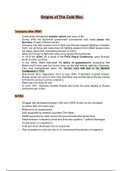Summary
Summary Entire Cold War Summarised with potential discursive topics
- Course
- History
- Institution
- Elkanah House
Entire Cold War Summarised: Origins, China, Relations between East and West, All conferences, Berlin Blockade/ Airlift, Cuba, Arms and Space Race, Interpretations of Cold War, Etc.
[Show more]




